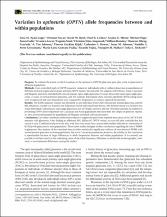Variation in Optineurin (OPTN) Allele Frequencies between and within Populations

Ver/
Trabajo
(application/pdf: 154.2Kb)
(application/pdf: 154.2Kb)
Fecha
2007-02-02Autor(es)
Ayala-Lugo, Rosa M.
Pawar, Hemant
Reed, David M.
Lichter, Paul R.
Moroi, Sayoko E.
Page, Michael
Eadie, James
Azocar, Verónica
Maul, Eugenio
Ntim Amponsah, Christine
Bromley, William
Obeng Nyarkoh, Ebenezer
Johnson, A. Tim
Guckian Kijek, Theresa
Downs, Catherine A.
Johnson, Jenae M.
Perez-Grossmann, Rodolfo A.
Guevara Fujita, María Luisa
Fujita, Ricardo
Wallace, Margaret R.
Richards, Julia E.
Metadatos
Mostrar el registro completo del ítemResumen
PURPOSE: To evaluate the extent to which mutations in the optineurin (OPTN) glaucoma gene play a role in glaucoma in
different populations.
METHODS: Case-controlled study of OPTN sequence variants in individuals with or without glaucoma in populations of
different ancestral origins and evaluate previous OPTN reports. We analyzed 314 subjects with African, Asian, Caucasian
and Hispanic ancestries included 229 cases of primary open-angle glaucoma, 51 cases of juvenile-onset open-angle glaucoma,
33 cases of normal tension glaucoma, and 371 controls. Polymerase chain reaction-amplified OPTN coding exons
were resequenced and case frequencies were compared to frequencies in controls matched for ancestry.
RESULTS: The E50K sequence variant was identified in one individual from Chile with normal tension glaucoma, and the
691_692insAG variant was found in one Ashkenazi Jewish individual from Russia. The R545Q variant was found in two
Asian individuals with primary open-angle glaucoma; one of Filipino ancestry and one of Korean ancestry. In addition to
presenting OPTN allele frequencies for Caucasian and Asian populations that have been the subject of previous reports,
we also present information for populations of Hispanic and black African ancestries.
CONCLUSIONS: Our study contributes additional evidence to support the previously reported association of the OPTN E50K
mutation with glaucoma. After finding an additional 691_692insAG OPTN variant, we can still only conclude that this
variant is rare. Combined analysis of our data with data from more than a dozen other studies indicates no association of
R545Q with glaucoma in most populations. Those same studies disagree in their conclusions regarding the role of M98K
in glaucoma. Our analysis of the combined data provides statistically significant evidence of association of M98K with
normal tension glaucoma in Asian populations, but not in Caucasian populations; however, the validity of this conclusion
is questionable because of large differences in allele frequencies between and within populations. It is currently not
possible to tell how much of the underlying cause of the allele frequency difference is attributable to demographic, technical, or ascertainment differences among the studies.
Colecciones
- Artículos [274]
Editor
Molecular Vision
Acceso
info:eu-repo/semantics/openAccess
Financiamiento
Universidad de San Martín de Porres. Facultad de Medicina Humana.







